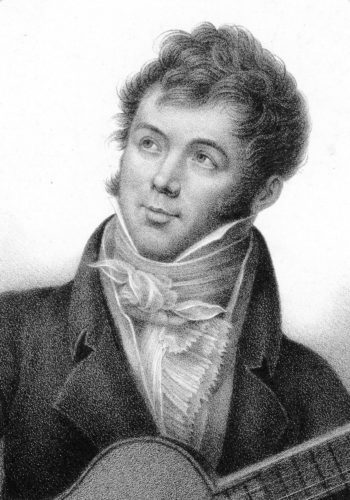
Of the many contemporary classical guitarists out there, nothing comes close to the prominence of Fernando Sor. He’s the brilliant brain behind symphonies, songs, and ballets.
In fact, many people consider him to be the best there is.
If you’re looking to perform Sor’s music, it’s best to learn more about him. Here’s what you need to know about Fernando Sor: guitarist and composer extraordinaire.
The Birth of Virtuoso Guitarist Fernando Sor
Fernando was born Joseph Fernando Macari Sors in 1778. Sor’s parents came from a relatively well-off family of career soldiers.
While the young Fernando was supposed to follow suit, he got sidetracked when Sor’s father showed him an Italian opera overture. He also treated him to classical guitar compositions, which prodded Fernando to abandon the original plan.
Young Sor’s talent was largely ignored by his parents, for they feared he’d abandon his military studies.
Ironically, Sor composed music in Latin in response to this treatment. He also created his way of notating music because he wasn’t formally taught how.
The musical abilities of the young composer didn’t go unnoticed. By age 12, Sor accepted the invite from the head of the Barcelona Cathedral.
The young Sor continued his studies at the Santa Maria Montserrat choir school. He stayed there for ten years. His mom feared this was distracting him, so he was shipped to military school. He studied there for four years.
Fernando Sor and His Desire to Write Nationalistic Music
In the year 1808, Napoleon Bonaparte invaded Spain. This inspired him to compose patriotic music.
He participated in traveling military bands, and they were known to play protest music in the streets.
While the Spanish guitar was Sor’s first love, he did not abandon his military profession. As a captain, he fought the French in Cordoba. Unfortunately, the Spanish military eventually succumbed to the French.
Sor then took an administrative post. He was officially labeled an afrancesado, a person who adopted French revolutionary ideas.
When the very Spanish he defied won over the French in 1813, Sor decided to leave the country. He feared retribution because of his ideals.
The Freedom to Play Classical Guitar
With his military life behind him, Sor focused on playing orchestral instruments instead. He wrote songs and composed music that many French people liked.
However, they rejected his operas.
For one, the sheet music of Op. 7 was seen as big and strange. Not one person can play the three clefs of Sor’s sonata style.
That’s when he decided to leave France for London in 1815. Again, people celebrated Sor’s guitar sonatas. Ballet was very popular in London at that time, so Sor began to focus on this. As such, his famous work Cendrillon was born.
Apart from composing, Sor also offered guitar and voice lessons.
By 1823, he relocated to Moscow with Félicité Hullin, who wanted to be a prima ballerina. Not much is known during his time there, although many exaggerated his romantic and professional life there.
Fernando Sor spent three years in Moscow, where he regularly performed in concerts. He was said to socialize in certain music circles as well.
With Age Comes a Stronger Music Career
As he aged, Sor moved back to Paris in 1827. While he enjoyed some fame in his previous travels, it wasn’t until this time when his career took off.
However, he was forced to complete guitar works according to the people’s tastes back then. He didn’t go public with this until the last decade of his life.
Take the case of his Op. 43 entitled Mes Ennuis and his six ballets. Sor reveals that he dedicated it to ‘whoever wanted them.’
As expected, these remarks did little to help the Master Composer.
That didn’t stop him from making remarks, though. Sor mentions this in his Op. 45:
“Let’s see if that’s that. Six short and easy pieces in stages, which aim to lead to what has generally been agreed are difficulties. Composed and dedicated to the person with the least patience, by Fernando Sor.”
Even at his advanced age, Fernando worked on his other guitar methods. His last masterpiece was a solemn mass, which he dedicated to his daughter. She passed away in 1837.
This didn’t help Sor’s health, for he plunged further into depression. Two years later, he eventually succumbed to tongue and throat cancer.
Fernando Sor’s grave is located in Montmartre Cemetery, Paris.
Fernando Sor, Prolific Guitarist and Composer
Sor wrote a vast music library. However, the most popular one remains to be Op. 9, Introduction and Variations on a Theme by Mozart. It was inspired by the Magic Flute, which was composed in 1791.
Both a composer and a teacher, Sor’s formal and stylistic procedures immensely helped his students. Today, his sheer classical works are currently organized according to difficulty. These are:
- Op. 60 – 25 lessons
- Op. 44 – 24 exercises
- Op. 35 – 24 lessons
- Op. 6 – 12 exercises
- Op. 29 – 12 lessons
Sor also published the didactic manual Méthode pour la Guitare in 1930.
Now that you know more about Fernando Sor, guitarist and composer, it’s plain to see why he’s considered the best in the world. Armed with his various orchestral instruments, he played the unique music that modern guitarists look up to.


